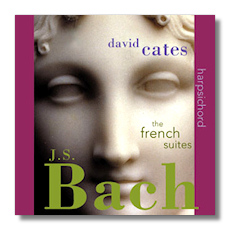
The Internet's Premier Classical Music Source
Related Links
- J.S. Bach Reviews
- Latest Reviews
- More Reviews
-
By Composer
-
Collections
DVD & Blu-ray
Books
Concert Reviews
Articles/Interviews
Software
Audio
Search Amazon
Recommended Links
Site News
 CD Review
CD Review
Johann Sebastian Bach

French Suites
- Suite #1 in D minor, BWV 812
- Suite #2 in C minor, BWV 813
- Suite #3 in B minor, BWV 814
- Suite #4 in E Flat Major, BWV 815
- Suite #5 in G Major, BWV 816
- Suite #6 in E Major, BWV 817
- Prelude in B minor, BWV 923
- Prelude in C minor, BWV 999
- Well-Tempered Clavier
- Prelude in D minor, BWV 851
- Prelude in E Major, BWV 854
- Prelude in G Major, BWV 884
David Cates, harpsichord
Music & Arts CD-1124 DDD 2CDs 95:00
Summary for the Busy Executive: For some, probably over the top.
Of the sets of keyboard music Bach composed – the Goldberg Variations, the Well-tempered Clavier, the partitas, and the English Suites – the French Suites are probably his least complicated. They lack the dramatic contrasts of the English Suites, the keyboard brilliance of the partitas, and the architectural mastery of the Goldbergs. "Complication" is, of course, a relative term (it's, after all, Bach), and these suites still function at a higher level than something like Handel's otherwise delightful keyboard pieces.
I suppose the performer must face the question of what to do with these works, since they really are, for Bach, rather low-key, and, of course, the composer provides very little interpretive help. Bach has further obscured things by failing to provide, as in the English Suites, a first-movement prelude for all but the fourth suite, and yet one finds documentary evidence for the sixth that links a fugitive piece to the suite as a prelude. For a music historian, this counts as a strong precedent: one can reasonably tack on a prelude (in the same key) to each of the suites. This points, I think, to their relative structural laxity as complete works. You wouldn't dream of interpolating something into, say, the Goldbergs. So Cates has taken this path by beginning suites with preludes from Book I of the Well-tempered Clavier (from around the same period as the French Suites), one from Book II, and with two fugitive pieces, one for keyboard and one for lute.
That said, Cates's performance drove me crazy, as schmaltzy a Bach as I've heard in a while – Phil Spitalny rubatos, exaggerated tempo shifts, and an aversion to hitting two simultaneous notes cleanly, without a slight roll (left-hand finger first, right-hand finger a split second later). It's as if Cates really wants to do them on the piano – with its gradation of dynamic and touch and its longer decay, far more forgiving of this approach – or doesn't trust the music to "speak" without extraordinary help. On the other hand, particularly in the fast pieces (played far more cleanly, by the way), I can't deny that he generates a real excitement, all too often missing from recordings of these pieces. Also, the sound of the particular harpsichord he plays is gorgeous, an Owen Daly copy of 1681 Vaudry in the Victoria and Albert museum. As much as some of this turns me off, I can't dismiss Cates. He's a player who knows how to get music out of notes. I simply don't care for some of what he does, although others might.
Who knows? Cates, like Virgil Fox, may grow on me.
Copyright © 2008, Steve Schwartz




















